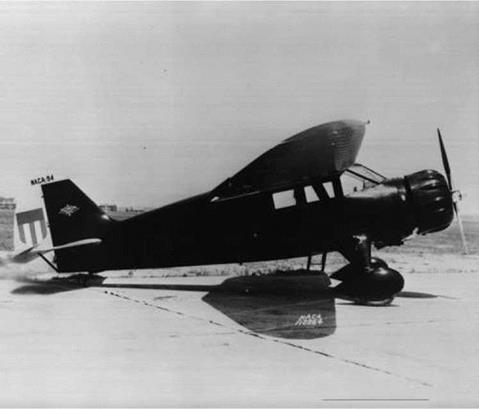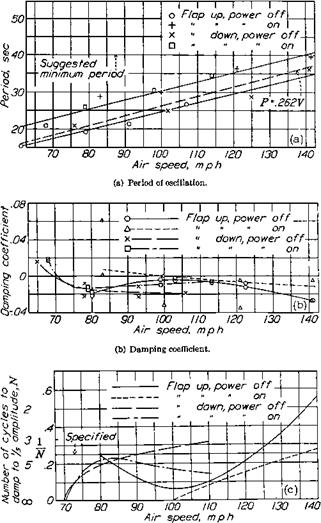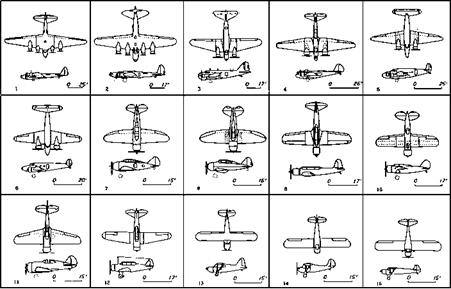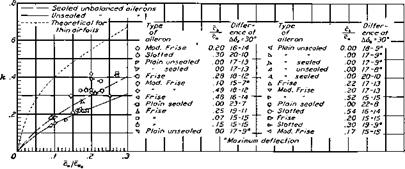The First Flying Qualities Specification
Edward P Warner, acting as a consultant to the Douglas Aircraft Company in the design of the DC-4E transport, has the distinction of having first embodied flying qualities research into a specification that could be applied to a new airplane design, much as characteristics such as strength and performance had been specified previously. Warner’s 1935 requirements were based on interviews with airline pilots, industrial and research test pilots, and NACA staff engineers. Warner also recognized the need to put flying qualities requirements on a sounder basis by instrumented flight tests correlated with pilot opinions.
3.2 Hartley Soule and Floyd Thompson at Langley
Warner’s ideas were picked up by the NACA (Warner was, after all, a member of the main committee; his ideas counted), and the grand comprehensive attack on airplane flying qualities started. The authorizing document was NACA Research Authorization number 509, “Preliminary Study of Control Requirements for Large Transport Aircraft” (Hansen, 1987). Hartley A. Soule (Figure 3.3), a portly, worldly-wise staff member at the NACA Langley Aeronautical Laboratories in Hampton, Virginia, ran tests the following year (1936) that attempted to correlate the long-period longitudinal or phugoid mode of motion with pilots’ opinions on handling qualities. The phugoid motion involves large pitch attitude and height changes at essentially constant angles of attack. Eight single-engine airplanes were tested by Soule and his group. This pioneering attempt showed that neither period nor damping of the phugoid motion had any correlation with pilot opinion.
However, the NACA was fairly launched on the idea of correlating flying qualities measurements with pilots’ opinions. Soule and his associate, Floyd L. Thompson, outlined the practical steps needed to carry out Warner’s ideas. Flying qualities had to be defined “in terms of factors known to be susceptible of measurement by existing NACA instruments or by instruments that could be readily designed or developed.”
Thompson and Soule started with what we would now call a set of “straw man” requirements based on Warner’s work, but modified to be measurable by NACA’s instruments. They used a Stinson Reliant SR-8E single-engined high-wing cabin airplane (Figure 3.4) for the tests. It turned out that the only instruments that needed to be specially developed for the Stinson tests were force-measuring control wheel and rudder pedals. These used hydraulic cells developed by the Bendix Corporation as automobile brake pedal force indicators.
The “straw man” NACA requirements seemed to ignore Soule’s previous findings of the unimportance of the longitudinal phugoid motion, and a reasonably well-damped oscillation of period not less than 40 seconds was specified. Even more curiously, F. W. Lanchester’s research on the phugoid period was quite overlooked in the straw man requirements, although Lanchester’s results were given in the well-known 1934 “Dynamics of the Airplane,” by B. Melvill Jones, which was included in Volume V of W. F. Durand’s Aerodynamic Theory. Lanchester had shown that the phugoid period for all aircraft was linearly proportional to airspeed and would invariably fall below the required 40 seconds at airspeeds under about 150 miles per hour.
|
Figure 3.3 Hartley A. Soule (1905- ), a pioneer in flying qualities research. (From Hansen, Engineer in Charge, NASA SP-4305, 1987) |
Aside from this cavil, Soule’s research followed reasonable lines. Each straw man requirement was stated, test procedures to check each requirement were spelled out, and the test results were presented and discussed. Some of Soule’s 1940 test procedures have come down to our day virtually unchanged except for the increased sophistication of data recording. For example, there were measurements of elevator angle and stick force for equilibrium flight at various airspeeds, measurements of time to bank to a specified angle, and, most advanced of all, measurements of the period and damping of the phugoid oscillation
|
Figure 3.4 The Stinson SR-8E airplane used in Hartley Soule’s pioneering stability and control flight test measurements. (FromNACA Rept. 700, 1940) |
as a function of airspeed (Figure 3.5). The Lanchester approximation for phugoid period is shown as a dashed line in Figure 3.5(a).
In his published report Soule (1940) provides the variations with airspeed for equilibrium flight of both the elevator angle and the control column position from the dashboard. These data would give exactly the same trends were it not for stretch of the control cables that connect the two, under load. Vincenti’s book tells the interesting story of the discovery of the effects of cable stretch on the Stinson data.
Soule’s report was reviewed in preliminary form by engineers at the Chance Vought Aircraft plant in Connecticut, who noticed that different incidence settings of the horizontal tail affected the variations in elevator angle for equilibrium flight, an unexpected outcome. C. J. McCarthy of Chance Vought wrote to Soule suggesting that the discrepancy might be explained by control cable stretch if the elevator angle had been deduced from the control column position, rather than having been measured directly at the surface itself. According to Vincenti:
Robert R. Gilruth, a young engineer who had recently taken over the flying quality program when Soule moved to wind tunnel duties, measured the stretch under applied loads and found that Chance Vought’s supposition was in fact correct… In tests of later airplanes, elevator angles were measured directly at the elevator. Such matters seem obvious in retrospect, but they have to become known somehow.
|
Figure 3.5 Dynamic stability measurements for the Stinson SR-8E, made around 1937 by Hartley Soule. (FromNACA Rept. 700, 1940) |
Some Stinson measurements called for by the straw man requirements are definitely archaic and not a part of modern flying qualities. Very specific requirements were put on the time needed to change pitch attitude by 5 degrees; these were checked. Likewise, the need to limit adverse yaw in aileron rolls was dealt with by measuring maximum yawing acceleration and comparing it with rolling acceleration. The yaw value was supposed to be less than 20 percent of the roll value. However, all of the pieces were in place now and ready for the next major step.
After the Stinson tests the NACA had the opportunity to test a large airplane, the Martin B-10B bomber. Those results went to the Air Corps in a confidential report of 1938. According to Vincenti, Edward Warner was able to feed back both the Stinson SR-8E and Martin B-10B results to his flying qualities requirements for the Douglas DC-4E, which was just beginning flight tests.
3.3 Robert Gilruth’s Breakthrough
Robert R. Gilruth (Figure 3.6) came to NACA’s Langley Laboratory in 1937 from the University of Minnesota. His slow, direct speech reflected his midwestern origins. He is remembered for a remarkable ability to penetrate to the heart of problems and to convince and inspire other people to follow his lead. When Gilruth fixed one with a penetrating stare and, with a few nods, explained some point, there was not much argument. Many
|
Figure 3.6 Robert R. Gilruth (1913-2000). An early expert in airplane flying qualities and design methods. He played a leading role later on in NASA’s space program. (From Hansen, Engineer in Charge, NASA SP-4305, 1987) |
years later, when NACA became NASA, Gilruth was tapped by the government to head the NASA Manned Spacecraft Center.
Gilruth’s seminal achievement was to rationalize flying qualities by separating airplanes into satisfactory and unsatisfactory categories for some characteristic, such as lateral control power, by pilot opinion. He then identified some numerical parameter that could make the separation. That is, for parameter values above some number, all aircraft were satisfactory, and vice versa. The final step was to develop simplified methods to evaluate this criterion parameter, methods that could be applied in preliminary design.
The great importance of this three-part method is that engineers now could design satisfactory flying qualities into their airplanes on the drawing board. Although proof of good flying qualities still required flight testing, engineers were much less in the dark. The old way of doing business is illustrated by an NACA report (W-81, ACR May 1942) on the development of satisfactory flying qualities on the Douglas SBD-1 dive bomber. Discussing a Phase III series of tests in September 1939, the report said, “The best configuration from this phase was submitted to a pilot representative from the [Navy] Bureau [of Aeronautics], who considered that insufficient improvements [in control force characteristics] had been made.”
Two applications of this new method were published (1941) by Gilruth and co-authors Maurice D. White and W. N. Turner to static longitudinal stability and to lateral control power, respectively. White had joined Gilruth at Langley in 1938. Fifteen airplanes ranging in size from the Aeronca K to the Boeing B-15 were tested in the first series, on longitudinal stability. Gilruth and White suggested a design value of 0.5 for the gradient of elevator angle with angle of attack, for the propeller-idling condition, to ensure power-on stability and adequate stick movement in maneuvers.
In the lateral control application of the new method, 28 different wing-aileron combinations were tested, including alterations to the wings and ailerons of two of the airplanes tested (Figure 3.7). The famous lateral control criterion function pb/2V came into being as a result of this work. pb/2V is the helix angle described by a wing tip during a full-aileron
|
Figure 3.7 The 15 airplanes tested by Gilruth and White to get data for their longitudinal stability estimation method. (From NACA Rept. 711, 1941) |
|
Turner. At the minimum allowable pb/2V value of 0.07 radian, the roll helix angle creates a complete roll in a forward distance traveled of 44.8 wing spans, regardless of the airspeed. |
roll. Gilruth and Turner fixed the minimum satisfactory value of the full-aileron pb/2V as 0.07, expressed in radian measure (Figure 3.8). A remarkably simple preliminary design estimation technique for pb/2V was presented, based on a single-degree-of-freedom model for aileron rolls (Figure 3.9).
Robert Gilruth’s early flying qualities work was closed out with publication (1943) of “Requirements for Satisfactory Flying Qualities of Airplanes.” This work had appeared in classified form in April 1941. A three-part format was used. First, the requirement was stated. Then there were reasons for the requirement, generally based on flight tests. Finally, there were “Design Considerations” related to the requirement, the all-important methods that would permit engineers to comply with the requirements for ships still on the drawing board.
Gilruth’s 1943 work introduced the concept of the pilot’s stick deflection and force in maneuvers and the criteria of control deflection per g and stick force per g. Vincenti points out that the control deflection and stick force per g criteria may have been independently conceived in Britain by S. B. Gates (Figure 3.10). Prior to the Gilruth/Gates criteria, stability and control dealt with equilibrium or straight flight conditions. W. H. Phillips calls this quantization of maneuverability one of Gilruth’s most important contributions to airplane flying qualities.
|
Figure 3.9 The control surface effectiveness derivative к, back-figured from flight tests of 28 different airplane configurations. Wing twist, control system stretch, and nonlinearities at large control angles all account for the markedly lower values than the Glauert thin airfoil theory, shown dotted. (From Gilruth and White, NACA Rept. 715, 1941) |




















